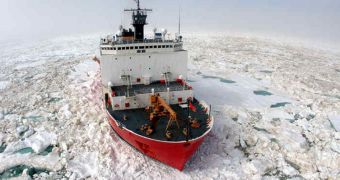Officials at NASA announce that the agency is about to embark on the first-ever mission destined for the ultra-cold water of the North Pole. The group of investigators that will join the expedition wants to look at how the Arctic climate is changing in closer detail. They are also interested in seeing precisely how ice conditions shift with time at the same locations. This is the first time the American space agency conducts sets of such experiments, and for this particular occasion, experts collaborated with colleagues from the US Coast Guard, OurAmazingPlanet reports.
The mission will set sail from Dutch Harbor, Alaska, and officials say that the voyage will most likely begin on June 15. The team will be hosted aboard the US Coast Guard (USCG) icebreaker Healy, which is capable of providing excellent study conditions for a group of about 50 researchers. The new effort has been dubbed Impacts of Climate on Ecosystems and Chemistry of the Arctic Pacific Environment (ICESCAPE) mission. The recent announcements were made by NASA ocean biology and biogeochemistry program manager Paula Bontempi, who added that the trip would last for a total of about five weeks.
“We're continuing the objective that we have to pioneer scientific discoveries. We're trying to understand and protect our home planet,” Bontempi explains. “To me what's really exciting about [the new voyage and research] is the biological connections,” explains expert Don Perovich, who is a co-chief scientist on ICESCAPE. He holds an appointment at the Hanover, New Hampshire-based Cold Regions Research and Engineering Laboratory. Members of the team that will go to the Arctic believe that the full extent of the influence global warming and climate change are exerting on the Northern Region cannot be readily and accurately determined from satellites.
As such, they will be using the icebreaker Healy to make their way to the very root of the problem. Using the state-of-the-art facilities on the new ship, the investigators will be able to conduct complex studies and assessments of the ice. The vessel has numerous laboratories, and features two helicopter hangars, in addition to a polar-oriented library. The cruise will take the scientists through the Bering Strait, and then onward into the Chukchi and Beaufort seas.

 14 DAY TRIAL //
14 DAY TRIAL //